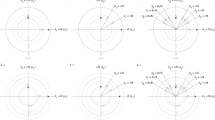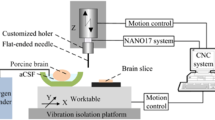Abstract
We present experimental findings regarding variability and stability of the electrical impedance properties of medical grade stainless steel needle electrodes in vitro. Monopolar impedance spectra (1 Hz to 1 MHz) were measured and scanning electron microscope images were obtained for five needle types with active electrode area from 0.28 to 0.7 mm2. A saline tank (0.9% NaCl) was used as tissue model. Measurements were done before and after electrolytic treatment with anodic and cathodic DC currents of 1 μA. With active electrode areas below 1 mm2, high influence from electrode polarization impedance (EPI) was expected at low frequencies (LF). For higher frequencies (HF) the EPI decreases and the impedance of the surrounding tissue is more pronounced. The hypothesis tested was that the EPI at LF would depend upon contact area, alloy composition, surface structure, and treatment of the active electrode, and at HF upon the electrode area geometry, and the specific resistivity of saline. Our results show large differences in electrical properties between needle types. After electrolytic treatment the EPI decreased. After 5–48 h of saline exposure the EPI increased, both for treated and untreated needles. Cathodic treatment gave lower impedance and drift than anodic or no treatment.








Similar content being viewed by others
References
Brummer, S. B., and M. J. Turner. Electrical stimulation with Pt electrodes: I—A method for determination of “real” electrode areas. IEEE Trans. Bio. Eng. 24(5):436–439, 1977.
Bordi, F., C. Cametti, and T. Gili. Reduction of the contribution of electrode polarization effects in the radiowave dielectric measurements of highly conductive biological cell suspensions. Bioelectrochemistry (Amsterdam Netherlands) 54(1):53–61, 2001.
Buchthal, F., and A. Rosenfalck. Evoked action potentials and conduction velocity in human sensory nerves. Brain Res. 3:1–122, 1966.
Butson, C. R., C. B. Marks, and C. C. McIntyre. Sources and effects of electrode impedance during deep brain stimulation. Clin. Neurophysiol. 117:447–454, 2006.
Cooper, R. The electrical properties of salt-water solutions over the frequency range 1–400 Mc/s. J. Inst. Elect. Eng. 93:69–75, 1946.
Dorfman, L. J., K. C. McGill, and K. L. Cummins. Electrical properties of commercial concentric EMG electrodes. Muscle Nerve 8:1–8, 1985.
Fricke, H. The theory of electrolyte polarization. Phil. Mag. 14:310–318, 1932.
Geddes, L. A., C. P. Da Costa, and G. Wise. The impedance of stainless steel electrodes. Med. Biol. Eng. 9:511–521, 1971.
Gray, J. R. Conductivity analyzers and their applications. In: Environment Instrumentation and Analysis Handbook, edited by R. D. Down and J. H. Lehr. Wiley, 2004, pp. 491–510.
Grimnes, S. Impedance measurement of individual skin surface electrodes. Med. Biol. Eng. Comput. 21:750–755, 1983.
Grimnes, S., and Ø. G. Martinsen. Bioimpedance & Bioelectricity Basics (2nd ed.). San Diego: Academic Press, p. 471, 2008.
Guth, U., V. Winfried, and J. Zosel. Recent developments in electrochemical sensor application and technology—a review. Meas. Sci. Technol. 20:1–14, 2009.
Jarzabek, G., and Z. Borkowska. On the real surface area of smooth solid electrodes. Electrochim. Acta 42:2915–2918, 1997.
Johnson, M. D., K. J. Otto, J. C. Williams, and D. R. Kipke. Bias voltages at microelectrodes change neural interface properties in vivo. In: Proceedings of the 26th Conference IEEE EMBS, 2004, pp. 4103–4106.
Kalvøy, H., L. Frich, S. Grimnes, Ø. G. Martinsen, P. K. Hol, and A. Stubbhaug. Impedance based tissue discrimination for needle guidance. Physiol. Meas. 30:129–140, 2009.
Kalvøy, H., B. Nordbotten, C. Tronstad, Ø. G. Martinsen, and S. Grimnes. Impedance properties of stainless steel needle electrodes. Proc. WC2009 IFMBE 25:380–383, 2009.
Khambete, N. D., J. Shashidhara, G. S. Bhuvaneshwar, and R. Sivakumar. Impedance measurement system for concentric needle electrodes. In: Proceedings of the RC IEEE-EMBS & 14th, 1995, pp. 1.1–1.2.
Kinouchi, Y., T. Iritani, T. Morimoto, and S. Ohyama. Fast in vivo measurements of local tissue impedances using needle electrodes. Med. Biol. Eng. Comput. 35:486–492, 1997.
Ludin, H. P. Electromyography in Practice. Stuttgart-New York: Thieme, 1980.
Merrill, D. R., M. Bikson, and J. G. R. Jeggerys. Invited review. Electrical stimulation of excitable tissue: design of efficacious and safe protocols. J. Neurosci. Methods 141:171–198, 2005.
Mirtaheri, P., S. Grimnes, and Ø. G. Martinsen. Electrode polarization impedance in weak NaCl aqueous solutions. IEEE Trans. Biomed. Eng. 52:2093–2099, 2005.
Mirtaheri, P., S. Grimnes, Ø. G. Martinsen, and T. I. Tønnessen. A new biomedical sensor for measuring PCO2. Physiol. Meas. 25:421–436, 2004.
Sauter, A. R., M. S. Dodgson, H. Kalvøy, S. Grimnes, A. Stubhaug, and Ø. Klaastad. Current threshold for nerve stimulation depends on electrical impedance of the tissue: a study of ultrasound-guided electrical nerve stimulation of the median nerve. Anesth. Analg. 108(4):1338–1343, 2009.
Schaldach, M. New aspects in electrostimulation of the heart. Med. Prog. Technol. 21:1–16, 1995.
Schwan, H. P. Determination of biological impedances. In: Physical Techniques in Biological Research, Vol. 6, edited by W. L. Nastuk. New York: Academic, 1963, pp. 323–407.
Schwan, H. P. Linear and nonlinear electrode polarization and biological materials. Ann. Biomed. Eng. 20:269–288, 1992.
Wiechers, D. O., R. Jeffrey, and W. Richard. EMG needle electrodes: electrical impedance. Arch. Phys. Med. Rehabil. 60:364–369, 1979.
Woo, E. J., S. Tungjitkusolmun, H. Cao, J. Z. Tsai, J. G. Webster, V. R. Vorperian, and J. A. Will. A new catheter design using needle electrode for subendocardial RF ablation of ventricular muscles: finite element analysis and in vitro experiments. IEEE Trans. Biomed. Eng. 47:23–31, 2000.
Acknowledgments
The authors would like to thank The Centre for Materials Science and Nanotechnology, University of Oslo for excellent assistance during the SEM-scans.
Author information
Authors and Affiliations
Corresponding author
Additional information
Associate Editor Larry V. McIntire oversaw the review of this article.
Rights and permissions
About this article
Cite this article
Kalvøy, H., Tronstad, C., Nordbotten, B. et al. Electrical Impedance of Stainless Steel Needle Electrodes. Ann Biomed Eng 38, 2371–2382 (2010). https://doi.org/10.1007/s10439-010-9989-2
Received:
Accepted:
Published:
Issue Date:
DOI: https://doi.org/10.1007/s10439-010-9989-2




